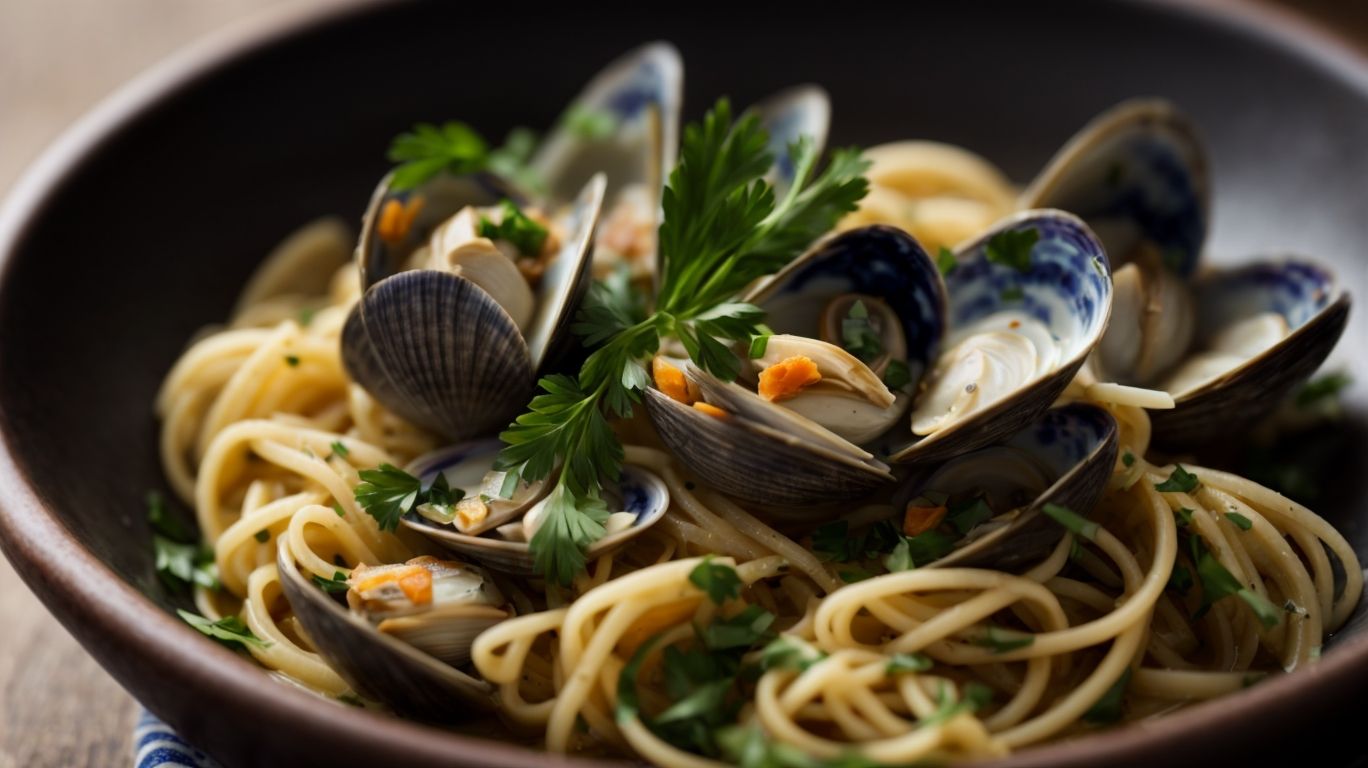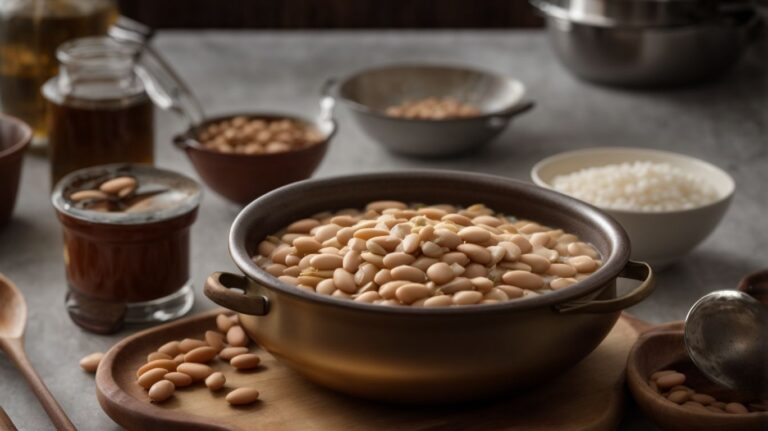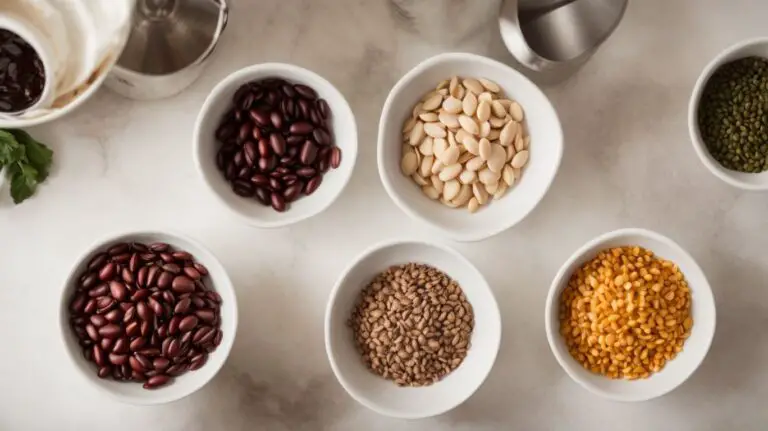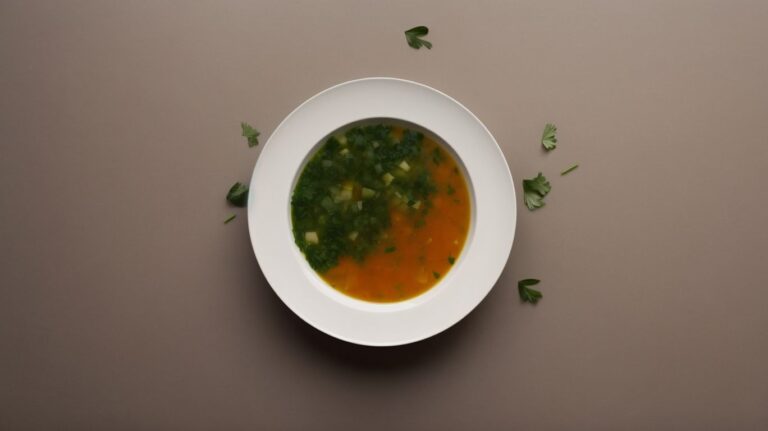How to Cook Vongole Without Wine?
Are you a fan of seafood dishes but not a fan of wine in your cooking? Look no further, as today we will be exploring the delicious world of Vongole – a classic Italian dish featuring clams, garlic, and parsley.
In this article, we will discuss the history of Vongole, the essential ingredients for cooking it, and how to prepare this mouthwatering dish without the use of wine.
Grab your apron and let’s get cooking!
Key Takeaways:
What is Vongole?
Vongole is a traditional Italian dish featuring clams as the star ingredient. This classic recipe is a popular choice among seafood enthusiasts and lovers of authentic Italian cuisine.
Clams, known for their briny and delicate flavor, are the highlight of Vongole, adding a rich depth to the dish. Typically, Vongole is prepared with fresh clams, garlic, white wine, parsley, and a touch of chili flakes for a subtle kick of heat. The simplicity of the ingredients allows the natural essence of the clams to shine through, creating a dish that is both comforting and elegant.
In Italy, Vongole holds a special place in culinary traditions, particularly in coastal regions where seafood plays a prominent role. It is often enjoyed with a glass of crisp white wine, further enhancing the dining experience. Whether served over pasta or simply with crusty bread to soak up the flavorful broth, Vongole embodies the essence of Italian gastronomy.
History of Vongole
The history of Vongole traces back to the coastal regions of Italy, particularly Sicily and Naples, where this seafood delicacy has been enjoyed for generations.
Vongole, which translates to ‘clams’ in Italian, holds a special place in the culinary traditions of Italian coastal cuisine. These flavorful bivalves are commonly prepared with garlic, parsley, white wine, and olive oil, creating a simple yet delicious dish. In Sicily, Vongole Veraci is a popular variation made with tiny, sweet clams, while in Naples, Spaghetti alle Vongole is a signature pasta dish that showcases the freshness of the seafood. The use of Vongole in Italian cooking dates back centuries, reflecting the rich maritime heritage and close connection to the Mediterranean Sea.
Ingredients for Cooking Vongole
To prepare a delicious Vongole dish, gather fresh clams, aromatic garlic, high-quality olive oil, fragrant parsley, and other essential ingredients commonly found in traditional Italian seafood recipes.
Regarding selecting fresh clams for your Vongole, ensure they are alive and sourced from reputable seafood markets. The freshness of the clams is crucial, as they are the star ingredient that impart a rich and briny flavor to the dish. The aromatic garlic should be finely minced to infuse the sauce with its distinctive taste and aroma.
Olive oil plays a pivotal role in Italian cuisine and is a key component in enhancing the overall taste of Vongole. Opt for extra-virgin olive oil for its superior quality and fruity notes that complement the seafood perfectly.
As for the fragrant parsley, its fresh leaves should be chopped just before adding them to the dish to maximize their flavor and vibrant color. This herb not only adds a fresh element but also balances the richness of the clams and olive oil.
Clams
The choice of clams for Vongole is crucial, with options such as littleneck clams, Manila clams, or cherry stone clams offering distinct flavors and textures to the dish.
Littleneck clams, known for their sweet and briny flavor, are a popular choice in many Vongole recipes. These small clams have tender, chewy meat that pairs well with garlic, parsley, and white wine sauces typical of the dish.
Manila clams, characterized by their larger size and delicate taste, add a subtle oceanic essence to the dish. They are often preferred for their softer texture and ability to absorb the flavors of the sauce beautifully.
Cherry stone clams, bigger in size compared to littlenecks, offer a meatier bite, making them a heartier option for those who enjoy a more substantial clam presence in their Vongole.
Garlic
Garlic plays a central role in enhancing the flavor profile of Vongole, infusing the dish with its aromatic essence and savory notes.
Garlic, with its pungent yet mellow taste, not only adds depth to the briny sweetness of the clams but also provides a subtle kick that elevates the overall taste experience. It is the foundation of many iconic Italian dishes, such as spaghetti aglio e olio and traditional bruschetta, showcasing its incredible culinary versatility.
Garlic bulbs are a staple in Italian cuisine, praised not only for their taste but also for their potential health benefits, including antioxidant properties and immune-boosting effects.
Olive Oil
High-quality olive oil serves as the foundation of Vongole, providing richness and depth to the dish while complementing the natural flavors of the seafood and herbs.
Olive oil plays a crucial role in Vongole by acting as a medium that binds all the ingredients together, creating a harmonious blend of flavors. When drizzled over the clams and spaghetti, olive oil not only adds a luxurious texture but also enhances the dish’s overall aroma and taste profile. Its abundance of monounsaturated fats promotes heart health and offers protective benefits against various diseases.
Parsley
Fresh parsley, particularly Italian parsley, adds a vibrant burst of color and herbaceous aroma to Vongole, balancing the dish’s flavors and providing a visual appeal.
Italian parsley is a key ingredient in traditional Vongole recipes, enhancing the overall taste with its fresh and slightly peppery notes. This versatile herb is not only pleasing to the palate but also offers a wealth of health benefits, being a good source of vitamins A, C, and K. In Italian cuisine, parsley symbolizes freshness and authenticity, often used as a finishing touch to elevate the flavors of seafood dishes like Vongole. Its subtle yet distinctive flavor profile complements the briny sweetness of clams, making it a must-have herb for any seafood lover.
Salt and Pepper
Seasoning with salt and pepper is essential in Vongole preparation, ensuring a well-balanced and flavorful dish that enhances the natural taste of the clams and other ingredients.
The combination of salt and pepper plays a crucial role in Vongole seasoning. Salt not only enhances the overall flavor but also helps draw out moisture from the clams, intensifying their taste. On the other hand, pepper adds a subtle heat and depth to the dish, complementing the brininess of the seafood. When seasoning Vongole, it’s important to sprinkle salt and pepper evenly to ensure every bite is perfectly seasoned. The balance between these two key ingredients can truly elevate the dish to a new level of deliciousness.
How to Prepare Vongole Without Wine?

Credits: Poormet.Com – Sean Moore
For those looking to prepare Vongole without wine, there are alternative methods and ingredients that can be used to maintain the dish’s rich flavors and authenticity.
One popular substitution for white wine in Vongole recipes is to use vegetable or chicken broth as a base liquid, providing a savory depth to the dish. Another approach is to infuse citrus juices like lemon or orange to bring a bright acidity. Incorporating tomato-based sauces or diced tomatoes can add a touch of sweetness and complexity. To enhance the umami notes, you can sprinkle in some soy sauce or miso paste. Experimenting with different herbs such as parsley, thyme, or basil can further elevate the overall aroma and taste profile of the dish.
Cleaning and Soaking the Clams
Before cooking Vongole, it is essential to properly clean and soak the clams to remove any sand or impurities, ensuring a clean and enjoyable dining experience.
-
Start by placing the clams in a large bowl filled with cold water for about 20-30 minutes.
-
This helps the clams to purge any sand or grit they might have inside.
-
During this time, you can gently agitate the clams or sprinkle a little cornmeal over them to encourage the expulsion of any remaining impurities.
-
After soaking, rinse the clams under cold running water, scrubbing each one with a brush to remove any debris clinging to the shells.
-
Discard any clams with broken or open shells, as they may not be safe to eat.
Preparing the Garlic and Parsley Mixture
Creating a flavorful garlic and parsley mixture is a key step in Vongole preparation, infusing the dish with aromatic notes and herbal essence.
When making this essential mixture, it is crucial to finely chop the garlic to ensure even distribution of flavor. This helps prevent any overpowering raw garlic taste by allowing it to mellow and blend harmoniously with the other ingredients. Freshly chopped parsley adds a vibrant green color and fresh aroma to the dish, enhancing its visual appeal.
To elevate the flavor profile further, consider adding a pinch of red pepper flakes or a splash of white wine to the mixture. These subtle additions bring a pleasant kick of heat and complexity to the dish, balancing out the richness of the clams and enhancing the overall taste experience.
Cooking the Clams
Cooking the clams to perfection is crucial in Vongole preparation, ensuring that they are tender, flavorful, and harmoniously integrated into the dish’s overall composition.
Before you start cooking, it is essential to select the freshest clams available, preferably live ones that are tightly closed. To clean them, scrub the shells under running water to remove any sand or debris, discarding any that are already open and do not close when tapped. Regarding flavoring the Vongole, garlic, white wine, and fresh herbs such as parsley or basil are classic choices that complement the natural sweetness of the clams.
Alternative Ingredients for Vongole
When exploring alternative ingredients for Vongole, options like lemon juice and white grape juice can offer unique flavor profiles and refreshing twists to traditional recipes.
Using lemon juice in place of white wine brings a zesty and tangy element to the dish, creating a vibrant contrast to the briny flavors of the clams. The acidity of the lemon juice helps to enhance the seafood notes while adding a brightness that complements the overall taste.
Similarly, substituting white grape juice for white wine can introduce a hint of sweetness that balances the savory aspects of the Vongole. The natural fruitiness of the grape juice adds a delicate touch to the dish, imparting a subtle complexity to each bite.
Vegetable Broth
Using vegetable broth as an alternative in Vongole recipes can introduce a rich depth of flavor and savory complexity to the dish, complementing the natural sweetness of the clams.
Vegetable broth, made from simmering a variety of vegetables with herbs and spices, offers a versatile base that can elevate the taste profile of Vongole with its earthy notes.
Vegetable broth provides a healthier option compared to traditional broth varieties, as it is lower in calories and fat while still imparting a robust umami essence.
For those looking to enhance the umami factor, consider adding ingredients such as dried mushrooms or miso paste to the vegetable broth for an extra burst of savoriness.
Lemon Juice
Adding a splash of lemon juice to Vongole can brighten the flavors, imparting a tangy zest that complements the brininess of the clams and enhances the overall taste of the dish.
Not only does the lemon juice add a refreshing citrus note, but it also helps balance the richness of the broth, making each spoonful a harmonious blend of savory and tangy flavors.
When paired with garlic, parsley, and a hint of white wine, the lemon juice creates a symphony of tastes that dance on your palate with every bite of the succulent clams.
Whether drizzled right before serving or squeezed over the finished dish, the acidity of the lemon juice lends a brightness that elevates the classic Vongole recipe to a new level of sophistication.
White Grape Juice
Incorporating white grape juice into Vongole dishes can introduce a subtle sweetness and fruity undertone, adding a unique twist to the traditional recipe while complementing the seafood flavors.
White grape juice, with its delicate flavor profile, acts as a natural enhancer, enriching the overall taste experience. The gentle acidity of the juice balances the brininess of the clams, creating a harmonious blend of flavors that tantalize the palate.
When using white grape juice in Vongole preparations, it is essential to simmer it gently with the clams to allow the flavors to infuse properly. This slow-cooking method ensures that the sweetness from the grape juice permeates through the dish without overpowering the seafood essence.
Tips for Cooking Vongole Without Wine
When preparing Vongole without wine, consider tips and techniques to enhance the dish’s flavors, textures, and overall dining experience without compromising on taste or authenticity.
To maintain the umami-rich depth in the absence of wine, you can opt for a splash of vermouth, clam juice, or even a dash of lemon juice for acidity. Balancing the flavors is key, so utilizing high-quality olive oil and fresh herbs like parsley can elevate the dish.
Regarding ingredient substitutions, using a vegetable or chicken broth can infuse the dish with additional layers of flavor. Season with a pinch of salt and a sprinkle of red pepper flakes for a burst of heat.
Consider adding a touch of tomato paste for richness or coconut milk for a creamy finish, adding a unique twist to the traditional recipe. Experimenting with these alternatives can provide a delightful variation while preserving the essence of the classic Vongole dish.
Conclusion
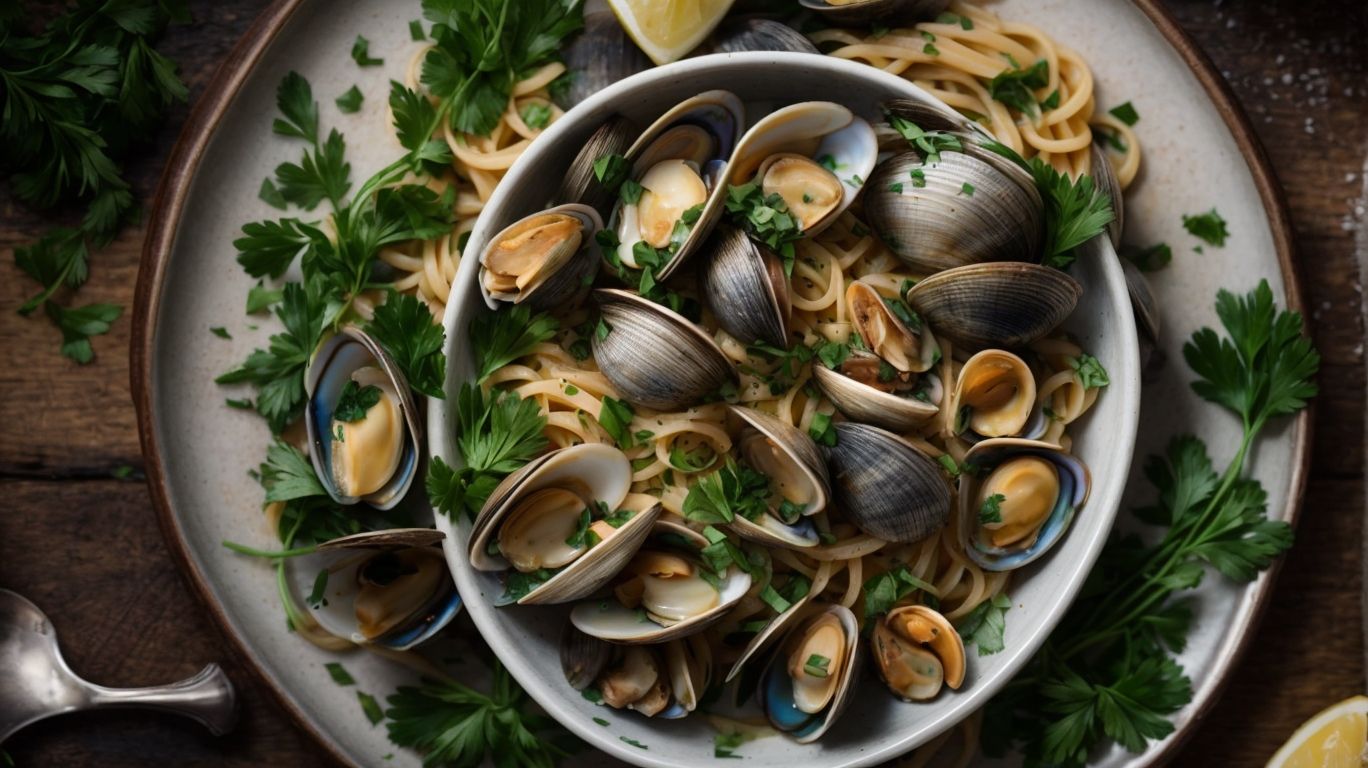
Credits: Poormet.Com – Alexander Williams
Vongole is a delightful seafood recipe that showcases the exquisite flavors of clams and traditional Italian ingredients, offering a culinary experience rich in taste, aroma, and cultural heritage.
Vongole, also known as spaghetti alle vongole, typically features fresh clams cooked with garlic, white wine, and parsley, creating a harmonious blend of savory and slightly briny notes. The use of fresh clams is crucial to achieve the dish’s authentic taste, ensuring each bite bursts with the essence of the sea. This classic Italian dish holds a special place in Mediterranean cuisine, reflecting the coastal regions’ reliance on bountiful seafood catch and the simplicity of preparing dishes that highlight the natural flavors of the sea.
Frequently Asked Questions
What is Vongole and why is wine usually used in cooking it?
Vongole is an Italian dish consisting of cooked clams and pasta. Wine is commonly used in cooking vongole to add a depth of flavor and enhance the overall taste of the dish.
Can I substitute wine with any other ingredient?
Yes, you can substitute wine with chicken or vegetable broth, clam juice, or even water. Each of these options will add a different flavor profile to your dish, so choose the one that best complements your other ingredients.
How much wine should I use in cooking vongole?
It is recommended to use about ¼ cup of wine for every pound of clams. This will give the dish a subtle wine flavor without overpowering the other ingredients.
What should I do if I don’t have any wine on hand?
If you don’t have wine on hand, you can omit it from the recipe or use a substitute as mentioned earlier. You can also use a combination of lemon juice and chicken broth to replicate the acidic and flavorful properties of wine.
Are there any tips for cooking vongole without wine?
One tip is to add a splash of white vinegar to your substitute ingredient, such as broth or water, to mimic the acidity of wine. Another tip is to add a pinch of dried oregano or red pepper flakes to add some depth and spice to the dish.
Is there a noticeable difference in taste when cooking vongole without wine?
The absence of wine may result in a slightly less complex flavor profile, but it can still be just as delicious. The key is to use high-quality ingredients and seasonings to make up for the lack of wine. You can also experiment with different substitutes to find the best combination for your taste preferences.

